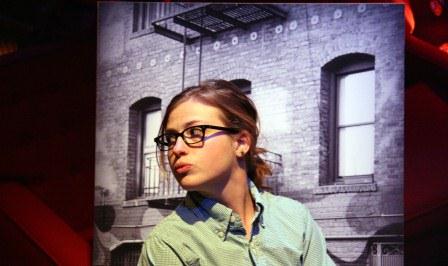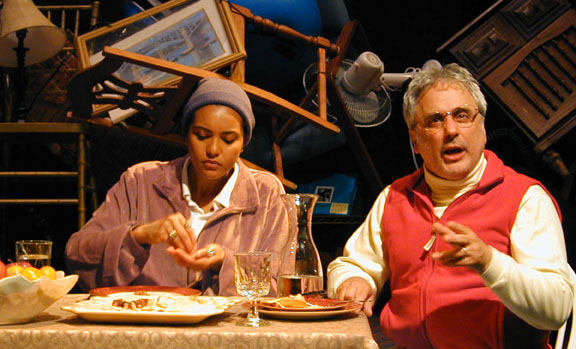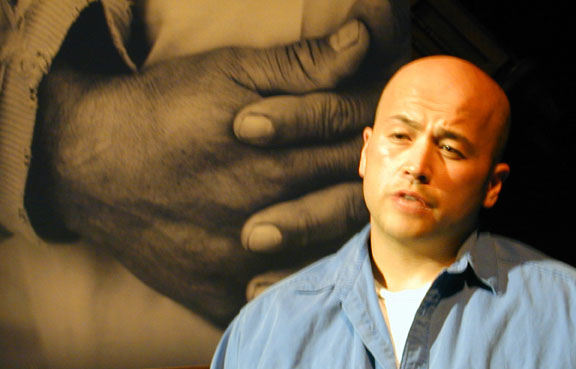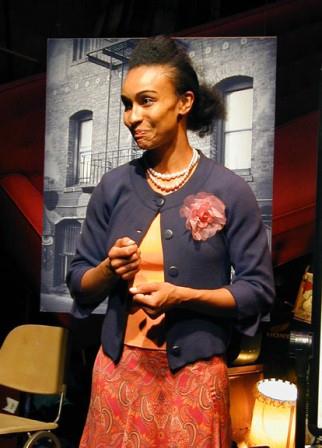
Those who pass through the San Francisco's Tenderloin District know it as one of the nation's grittiest concentrations of single-room occupancy hotels (many of which are filled with a mixture of drug addicts, seniors living on fixed incomes, and Vietnamese immigrants). At any hour of day or night, life on the Tenderloin's streets can seem threatening, depressing, drunk and/or demented.
Like New York's Lower East Side more than 100 years ago, it is filled with the types of people Emma Lazarus described in 1883 as "your tired, your poor, your huddled masses yearning to breathe free ... the wretched refuse of your teeming shore ... the homeless, tempest tost."
On one block of Eddy Street is the infamous Tearoom Theatre, a rundown movie house specializing in gay porn where I once collapsed in giggles upon realizing that a pornographer with artistic aspirations had used the overture to Mozart's opera, The Marriage of Figaro, to accompany a rather bland and boring seduction scene. Directly opposite are the EXIT Theatre (which, in addition to presenting the San Francisco Fringe Festival, DivaFEST, SFOlympians, and numerous other productions, is Cutting Ball Theatre's landlord) and the Empress Hotel.
The first thing one notices upon entering the tiny performing space where Cutting Ball Theatre is presenting the world premiere production of Tenderloin is the wonderful, topsy-turvy unit set designed by Michael Locher that captures the upside-down, inside-out turmoil of the lives of the neighborhood's residents. Locher's set is peppered with poignant black-and-white photographs by Mark Ellinger, a former heroin addict who found a new lease on life after someone gave him a digital camera that allowed Ellinger to document the architectural diversity of the Tenderloin.
As the cast of Tenderloin brings the show's characters to life, the nervous energy that is often found outside the theatre starts to seep inside its walls. The usual mixture of police sirens, honking horns, and arguing drunks drifts through the theatre's vents, reminding the audience that Tenderloin is very much a work that is "of the people, by the people, and for the people."

Tristan Cunningham with the cast of Tenderloin (Photo by: Rob Melrose)
Under the guidance of director Annie Elias, the actors involved in this docudrama were an integral part of the play's developmental process. Just as Ellinger set about documenting the part of town in which he lives, the actors were given tape recorders and sent out to interview people who live in the Tenderloin (people they might otherwise avoid while walking down the street).
The actors were then tasked with transcribing their interviews (including every stuttering exclamation made by the interviewee) and paying careful attention to inflection, body language, and any other signs that could help them build authentic characterizations of the people they had interviewed. According to the production notes, one transcribed interview was 65 pages long. As dramaturg Erin Moro notes:
"In my research and transcribing of the interviews for this piece, I was touched by the musicality of the voices from the Tenderloin. The mere study of language through the spoken word was fascinating as I labored to capture each breath, stammer, and vocal inflection in the text. The people who live and serve in this neighborhood are passionate, vibrant people, with exciting stories and experiences that go way beyond what you see at first glance when you walk down the streets of the Tenderloin. The connection that the residents and workers of this neighborhood have to one another and to their physical surroundings is special and rare."

Leigh Shaw portrays Reverend Karen Oliveto from
Glide Memorial Church (Photo by: Rob Melrose)
In a curious approach to casting Tenderloin, the actors were tasked with portraying the characters they interviewed. Thus, the owners of the 105-year-old Cadillac Hotel are portrayed by members of the opposite sex, with Rebecca Frank appearing as 87-year-old Leroy B. Looper and David Sinaiko impersonating Looper's wife, Kathy (Sinaiko also appears as photographer Mark Ellinger).

Rebecca Frank as Leroy Looper and David Sinaiko as
Looper's wife, Kathy (Photo by: Rob Melrose)
Weaving together the material gathered in interviews with Tenderloin residents has resulted in a collage of humanity reflecting the depth and diversity of the neighorhood's demographics.
- Siobhan Doherty plays Cara (a woman from Palo Alto who feels safer in the Tenderloin).
- Tristan Cunningham portrays filmmaker Rob Nilsson, Filipina Health and Wellness Director Ester Aure, city cleaning program worker and ex-con Shomari Kenyatta, a toothless middle-aged black man named William Ray Smith, and a young man named Jasper.
- Leigh Shaw portrays Glide Memorial Church's Reverend Karen Oliveto, Elaine Zamora, and a child named Kim.
- Michael Uy Kelly portrays Captain Gary Jimenez of the San Francisco Police Department, a Vietnamese refugee named Tony Nguyen, a tired old hooker named Collette Ashton, and a character whose nickname is "Nappy Chin."

Michael Uy Kelly as Vietnamese refugee
Tony Nguyen (Photo by: Rob Melrose)
Throughout the performance, I was especially impressed by the work of Michael Uy Kelly and Tristan Cunningham (whose radiant portrayal of Filipina Health and Wellness Director Ester Aure is worth the price of admission alone). Toward the end of the evening, some of the characters reach out and ask members of the audience for a hug, a smile, or a chance to simply shake hands.
Even though the Cutting Ball Theatre has no proscenium, it is a moment in which breaking the fourth wall is as challenging a gesture as acknowledging the humanity of the people who actually live on the streets of the Tenderloin. Tenderloin's director, Annie Elias, is quite open about the impact this project has had on her own life:
"Before making this piece it was my habit to traverse the Tenderloin in a way designed to have the least amount of interaction with the neighborhood. Once in the theatre, I would try to block out the sounds of the street that drifted in, intruding on my theatre experience. While we have attempted to pull back the layers and get beyond an outsider's first impression of the neighborhood and the people one encounters, there are many more layers to be discovered and many more stories that deserve to be heard. I hope you will take this piece as an entry point and an invitation to get to know this neighborhood better, to shed your own defense, look up and look beyond first impressions to see the vibrant humanity around us."

Tristan Cunningham as Filipina Health and Wellness Director,
Ester Aure (Photo by: Rob Melrose)
Tenderloin continues through June 3 at Cutting Ball Theatre (click here to order tickets).
To read more of George Heymont go to My Cultural Landscape
